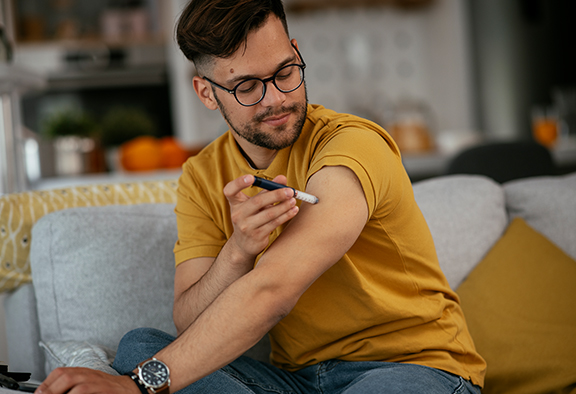November 13, 2020
10 Tips: Diabetes and Exercise
Our video shares 10 important safety tips for people with diabetes who are ready to start exercising! We'll cover tips like recommended exercise types and ways exercise impacts blood glucose levels.
Share This Story

10 Tips: Diabetes and Exercise
Let’s talk about exercise! In this video we’re going to go through 10 tips every person with diabetes should know to exercise safely and effectively. Before you get started it’s important to consult your doctor and make sure you’re cleared to start an exercise routine. The benefits of exercising are huge, especially for people with diabetes. Exercise is recommended to help manage your blood glucose levels, control your weight, and keep your heart healthy, just to name a few benefits. That’s reason enough to get going, right there!
Tip #1: Start Slow. Ease into it.
Our first tip is to start slow and ease into your exercise routine. For beginners, it’s important to start slow and build gradually. Exercise will impact your blood glucose levels so starting out with walking or light yoga at home is a great way to get your body moving, while still being able to monitor yourself. You can increase your speed, distance, or intensity with time, but until you know your body’s response, start slow. Always keep your phone, blood glucose monitor or continuous glucose monitor with you.
Tip #2: Keep a close eye on your glucose levels.
Test your blood sugar levels before, during, and after a workout. For most people with diabetes, the safest blood sugar range to start a workout is between 100 and 250 milligrams per deciliter but check with your doctor for their recommendation too. Levels above 250mg per deciliter can be dangerous. You must check for ketones. If you have high levels of ketones, you may be at risk for ketosis. You must wait until blood glucose levels come down before exercising.
Tip #3: Hydrate
This sounds obvious but it’s really important so listen up: stay hydrated! Drink water before, during and after your exercise to avoid the risk of dehydration and heat stroke.
Tip #4: Fuel up with healthy carbs.
Tip 4 involves eating, yum: Fuel up with healthy carbs. Even before you begin, if your blood sugar levels are below 100 milligrams per deciliter, before you exercise, have a snack that contains 15 grams of carbohydrate and test again in 15 minutes. During your exercise keep a protein bar or fast-acting glucose tabs nearby.
You’ll need to refuel with healthy carbs right after your workout, so test again. If it’s less than 100 milligrams per deciliter, have a snack. Your sugar level can drop for up to 24 hours after moderate or intense exercise. You may need to double your snack or talk to your doctor about lowering your insulin at bedtime.
Tip #5: Be ready for some highs and lows.
As a person with diabetes, you know to expect highs and lows, and that’s just what this tip is about. Exercise will affect your insulin absorption, so you need to talk to your doctor about how to adjust your insulin treatment prior to exercising.
Tip #6: Make it a habit. Stick to it!
Turn your exercise into habit so you can stick to it! Wear a smart watch or pedometer to give you daily prompts, leave your running shoes by the front door, or use a partner or friend to keep you accountable. Use any or all of these methods to turn regular exercise into a way of life. Your long-term health depends on it, so dig deep and stay motivated.
Tip #7: Find a work out buddy.
Just to reinforce the habit-forming aspect, our next tip is to find a workout buddy. Grab your neighbor, friend, or even your child and go for daily walks. Strike up a conversation with someone at the gym who seems to be on your schedule and make plans to meet regularly. Having a friend there will create that sense of accountability and bring a bit of extra enjoyment to your activity.
Tip #8: Carry a snack, in case your blood sugar drops.
Carry a snack, in case your blood sugar drops. We covered this in Tip 4, but it’s so important we’re covering it again! If you sugar drops you will need a fast-acting carbohydrate such as glucose tablets, sugar, honey, juice, or regular soda. After correcting the low you might want to snack on a piece of fruit or a snack bar. Have something portable that you can keep nearby while you exercise.
Tip #9: Keep active, even when not exercising.
We’re going to talk about keeping active all day. That’s right, even if you’re not exercising it’s still crucial to keep your body moving. If you have a desk job, try to stand for about one minute every hour. Do stretches and walk in place to keep your body in motion.
Tip #10: Have fun!
With so many options out there, find the activity that you truly enjoy. Enjoy the challenge of moving your body in new ways and feeling your strength increase. Try dancing, hiking, basketball or swimming…make it fun and you’ll be more inclined to keep it up!
Are you feeling motivated yet? Well, here’s an extra dose of encouragement. Exercise has been proven to lower the glucose in your blood! Regular exercise will also help your body use insulin more effectively, so don’t wait, talk to your doctor about your exercise routine today!
For more exercise and healthy diabetes lifestyle information, be sure to check out the blog! Looking for more healthy lifestyle recommendations? Try our diabetic-friendly recipes.
US MED Delivers
If you need to order your diabetic testing supplies or CGM supplies, visit our new customer page to get started. We accept private insurance and Medicare, so many of our supplies are available with low co-pays. Learn more here.







